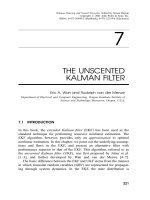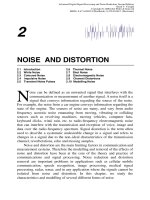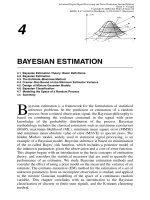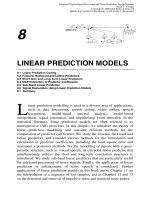Tài liệu Hormone Disruptors and Women’s Health pptx
Bạn đang xem bản rút gọn của tài liệu. Xem và tải ngay bản đầy đủ của tài liệu tại đây (1.16 MB, 11 trang )
A woman’s body changes throughout her lifetime. Each stage
of life, from fetal development to post-menopause, involves a
direct relationship between her hormones and how her body
develops and functions. When this relationship is in balance,
it helps create the conditions for good health. When this rela-
tionship is out of balance, it can lead to a range of health
problems that can be painful and devastating.
Increasingly, the scientific evidence shows that some
industrial chemicals, known as hormone disruptors, can
throw off this balance. As a result, women can be at
greater risk for experiencing health problems such as
infertility and breast cancer.
The Problem
Over the last 70 years, more than 80,000 chemi-
cals have been released into the environment
through human activity. Because of inadequate
health and safety laws, more than 85% of these
chemicals have never been assessed for possi-
ble effects on human health. Although many of
them may not cause harm, a significant number
of those that have been tested are now believed
to increase our risk for serious health problems.
Hormone disruptors are one category of these
chemicals that scientists are concerned about.
Although many different chemicals can increase
a woman’s risk for health problems, hormone dis-
ruptors are of particular concern because they can
alter the critical hormonal balances required for proper
health and development at all stages of a woman’s life.
This brochure summarizes some of the latest peer-
reviewed science about the risks hormone disruptors pose to
women and their reproductive health.
Hormone Disruptors and Women’s Health
Reasons for Concern
The Complexity of Health
No formula currently exists that can determine the exact effects hormone disruptors will have on a woman’s health. Research indi-
cates that the effects depend on the potency and dose of the chemical, the timing of the exposure and the individual’s overall health,
which can be shaped by her genetic makeup, diet, exercise habits, racial and economic disparities, sexually transmitted diseases,
access to health care and many other factors.
Hormones and Hormone Disruptors
Hormones regulate a wide range of functions in our bodies. Hormone disruptors* can interfere with these functions.
* Hormone disruptors are also referred to as endocrine disruptors.
Hormones
Clear Messages
Hormone Disruptors
Mixed Messages
WHAT
THEY ARE
Hormones are produced by the endocrine system,
which includes the ovaries (women), testes (men),
pituitary, thyroid, pancreas and other parts of the body.
They are then secreted into the blood as chemical
messengers. Examples of hormones include adrenaline,
estrogen, insulin, thyroid hormones and testosterone.
Hormone disruptors are substances not naturally
found in the body that interfere with the production,
release, transport, metabolism, binding, action or
elimination of the body’s natural hormones. Phthal-
ates, Bisphenol A (BPA) and DDT are some of the more
commonly known hormone disruptors.
WHAT
THEY DO
Hormones direct communication and coordination
among tissues throughout the body. For example,
hormones work with the nervous system, reproduc-
tive system, kidneys, gut, liver and fat to help maintain
and control body energy levels, reproduction, growth
and development, internal balance of body systems
(called homeostasis) and responses to surroundings,
stress and injury (1).
Hormone disruptors can scramble messages that
natural hormones transfer between cells. Usually hor-
mones bind to hormone receptors like a lock and key.
When the key fits, it unlocks the process of sending
messages to regulate functions in the body. Hormone
disruptors can interfere with this process. For example,
some can mimic natural hormones and bind to the
receptors, unlocking the process but sending the
wrong message.
Hypothalamus
Pituitary gland
Thymus
Stomach
Pancreas
Thyroid
Pineal
Parathyroids
(behind thyroid gland)
Adrenal
gland
Kidney
Duodenum
Ovary
2
Some hormone disruptors such as DDT (10) and PCBs (11) were banned more than
30 years ago but persist in the environment, animals and our bodies.
Examples of Hormone Disruptors
Atrazine
Atrazine is one of the most heavily used herbicides in the U.S. and is widely applied to corn and soy crops. It is
banned in the European Union due to concerns of ground water contamination (2).
BPA Bisphenol A (BPA) is commonly used in some plastic products such as sports bottles and baby bottles, in addition
to the linings of canned food and infant formula.
Cigarette
Smoke
First and Secondhand
Cigarette smoke contains hundreds of chemicals, including some hormone disruptors. More research is needed
to fully understand how cigarette smoke affects hormone function. This research is especially important because
cigarette smoke is very common and because so many health problems are associated with it.
DDT The pesticide dichloro diphenyl trichloroethane (DDT) was widely used in the U.S. until it was banned in 1972 due
to toxicity (3). DDE, a byproduct from the breakdown of DDT is also harmful. DDT is still used in some other coun-
tries, often to eliminate mosquitoes associated with malaria risk.
DES Diethylstilbestrol (DES) is an estrogenic compound that was first manufactured in 1938 and was prescribed to
prevent miscarriages. It is no longer used for this purpose because of the associated health risks.
Dioxins Dioxins are the byproducts of some manufacturing and incineration processes. The uncontrolled burning of resi-
dential waste is thought to be among the largest sources of dioxins in the United States (4).
PBBs Polybrominated biphenyls (PBBs) were used as a flame retardant in electrical appliances, textiles, plastic
foams and other products (5). In 1976 the manufacturing of PBBs ended in the U.S. after they contaminated
milk supplies (6,7).
PCBs Polychlorinated biphenyls (PCBs) are a class of compounds that were used as coolants and insulation in electrical
equipment (8), in coating of electrical wiring and for many other purposes. They were banned in the 1970s due to
their toxicity.
Phthalates Phthalates are a family of compounds used as a plasticizer in PVC (vinyl), cosmetics, fragrance and medical
devices. Some phthalates were banned from children’s products in 2008 (9).
How We Are Exposed
People can be exposed to hormone disruptors indoors and outdoors, at home and in the workplace. Hormone disruptors get into
our bodies when we breathe, eat, drink and have skin contact with them. They can be found in household products such as cosmet-
ics and plastic containers. They can come from industrial pollution and cigarette smoke. Some pesticides are hormone disruptors
and can end up on our food and in our waterways. Below are a few examples of hormone disruptors. More research is needed to
identify all hormone disruptors and their potential health impacts.
3
Early puberty is a growing concern. In
the U.S. girls get their first periods a few
months earlier than they did 40 years
ago, and they develop breasts one to
two years earlier (12). Early puberty has
been associated with polycystic ovar-
ian syndrome, obesity, breast cancer,
depression and a number of social chal-
lenges such as experimentation with
sex, alcohol or drugs at a younger age
(13). Phthalates (14-16), BPA (17), some pes-
ticides such as DDT (18-21), PCBs (22), PBBs
(23), cigarette smoke (24) and DES (25).
Impaired fertility or infertility
includes difficulty or the inability to get
pregnant and/or carry a pregnancy to
term. It is difficult to say for certain how
many people experience impaired fer-
tility, but the best estimate is 12% of the
reproductive age population in the U.S.
This number seems to have increased
over the last two decades, most sharply
in women under the age of 25 (26,27).
Menstrual irregularities and male infer-
tility contribute to this problem, as well
as other specific health concerns, which
are listed below. DDT (28-30), cigarette
smoke (31,32), phthalates (33) and PCBs
(34-36).
Polycystic ovarian syndrome (PCOS)
symptoms include irregular periods, pel-
vic pain and ovarian cysts (37). Women
with PCOS have a higher risk of devel-
oping insulin resistance, diabetes, endo-
metrial cancer, infertility, miscarriage
and hypertension (38,39). BPA (40,41).
Uterine fibroids occur in 25% to 50%
of all women, though some estimates are
much higher (42). Fibroids are the num-
ber one cause of hysterectomy in repro-
ductive age women (43) and can cause
pelvic pain, abnormally heavy periods,
abnormal uterine bleeding, infertility
and complications in pregnancy (44-49).
DES (50-55) and BPA (56).
Endometriosis occurs when the tissue
that lines the inside of the uterus (called
the endometrium) grows outside the
uterus on other parts of the body, for
example the ovaries, abdomen and pel-
vis. Estimates vary, but most studies find
between 10% and 15% of reproductive-
age women have endometriosis (57,58).
About 30% to 40% of women with endo-
metriosis are infertile, making it one of
the leading contributors to female infer-
tility (59). DES (60), dioxins (61-64), phtha-
lates (65,66) and PCBs (34,62,67-71).
Miscarriage affects up to 21% of
known pregnancies (72-74) and can be
caused by a variety of factors, especially
abnormal chromosomes (known as ane-
uploidy) (75). BPA (76), cigarette smoke
(32) and pesticides such as DDT (29).
Shortened lactation, or reducing
how long a woman can breastfeed her
baby, can have long-term impacts on
the child, including increased risk for
infection, chronic disease, compromised
immunity and obesity. Breastfeeding
helps build a child’s immune system
and later intelligence and is important
to the bonding and nurturing process
(77,78). PCBs (79-81) and pesticides such as
Atrazine (82) or DDT/DDE (79-81,83).
Breast cancer incidence rates in the
United States increased by more than
40% between 1973 and 1998. In 2008, a
woman’s lifetime risk of breast cancer is
one in eight (84). More than 200 chem-
icals, including numerous hormone
disruptors, have been associated with
increased incidence of breast tumors
(85). DES (86-89), BPA (90-96), first- or sec-
ond-hand smoke (97-103) and some pesti-
cides, especially early life exposure to DDT
(104,105).
Hormone Disruptors and Men’s
Health. This report focuses on the risks
of hormone disruptors and women’s
health, but these chemicals also pose
risks to males, especially from exposures
in the womb. Some of these risks include
hypospadias (a birth defect of the penis),
cryptochordism (undescended testicles),
impaired fertility from reduced sperm
count and semen quality, and some
cancers, including testicular and pros-
tate cancer.
Hormone disruptors are not the only
type of chemicals that can harm wom-
en’s health. Solvents, air pollution, heavy
metals such as lead and mercury and
many other contaminants can harm
people’s health. To learn about other
environmental contaminants, see the
references at the end of this brochure.
Women’s Reproductive Health Concerns
Animal studies designed to predict human harm, as well as a limited number of human studies, have helped researchers understand
some of the ways hormone disruptors can increase risk for various health problems. More research is needed, but below are descrip-
tions of some of these health problems and examples of associated hormone disruptors (in italics).
4
What We Are Learning
Research into hormone disruptors is changing our understanding of health risks. Traditional schools of thought are evolving to
reflect the complexity of how chemicals impact our health. Some trends in the research findings include:
Timing of Exposure
Throughout a woman’s lifetime, reproductive organs develop and change. Stages of rapid develop-
ment can be especially vulnerable to the effects of hormone disruptors, and exposure at these times
can increase risk for health problems later in life. For example, exposure to some hormone disruptors
before birth can increase the chance for early puberty, infertility and breast cancer.
Generational Effects
Hormone disruptors can cause multi-generational harm. The clearest example of this is DES, a drug
given to pregnant women for many years to prevent miscarriage (though it was ineffective). Many
DES daughters experience infertility and cancer in their reproductive organs (106,107) and breasts
(108). Animal studies show that the granddaughters of women who took DES are also at risk for ovar-
ian and uterine cancers (109).
Level of Exposure
For years it was assumed that everyday levels of chemical exposure would not harm our health, but
emerging research calls this into question. For example, some studies have found that low levels of BPA
can harm reproductive health in female mice (110) and their offspring (111). More research is needed to
fully understand how BPA impacts humans, but the Centers for Disease Control detected BPA in nearly
93% of the people they tested (112), raising new questions about its widespread use.
Hormone Activation Levels. Natural or synthetic hormones can activate changes at very low levels. This graph shows normal levels of natural estrogen
(estradiol) in women and levels of synthetic estrogen (ethinyl estradiol) and progestin (desogestrel) in women taking birth control. These levels are adequate to
activate significant functions, such as regulating menstural cycles and preventing pregnancy. BPA, which can mimic natural estrogen, can be found in the body
under normal conditions at the same or higher levels than these natural or synthetic hormones.
0 100 200 300 400 500 600 700 800 900 1000 4010
Levels (parts per trillion)
Natural estrogen in women
of reproductive years (113)
Synthetic estrogen in women
using birth control pills (114)
Synthetic progestin in women
using birth control pills (114)*
BPA in women (115)
* Levels of 3-keto-desogestrel, the metabolite of desogestrel.
5
This report summarizes the key outcomes of the Women’s Reproductive Health and the
Environment Workshop held at Commonweal in Bolinas, CA, January 6–9, 2008. Results
are published in “Female reproductive disorders: The roles of endocrine disrupting com-
pounds and developmental timing.” (See References for full citation).
The workshop was co-sponsored by the Collaborative on Health and the Environment
(CHE), the University of Florida (UF) and the University of California, San Francisco’s Pro-
gram on Reproductive Health and the Environment (PRHE). This event was co-chaired
by Dr. Louis Guillette at UF (www.zoology.ufl.edu/ljg) and Dr. Linda Giudice at PRHE
(www.prhe.ucsf.edu). Please contact these individuals for further information about this
research. Thanks to Sarah Janssen of Natural Resources Defense Council for contributing
to this brochure. Written by Heather Sarantis.
Funding for this project was provided by John Burbank and Alison Carlson, the Barbara
Smith Fund, the Johnson Family Foundation, The New York Community Trust and Turner
Foundation, Inc.
For copies of this brochure or for more information please contact CHE (www.
healthandenvironment.org).
What We Can Do
We know enough about hormone disruptors to know we have a problem. A coordinated effort between researchers, elected
officials, advocates, medical professionals, business leaders and the general public is needed to ensure that we are not put-
ting our families and future generations at undue risk. Some of the things we can do are:
Support better research on hormone disruptors, including:
Prioritize research funding to study the effects of hormone disruptors on women’s health.
•
Most of the research to date has been
focused on hormone disruptors and men, leaving more gaps in the research on women’s health.
Improve health tracking systems.• Currently the systems that track rates of various health problems are inadequate. In order
to understand the full impact of hormone disruptors on human health, collecting this information is critical.
Support long-term studies.
•
Because hormone disruptors can have life-long impacts, it is especially important to initiate stud-
ies tracking women’s health over large spans of their lives. This will help us understand long-term and multi-generational
effects.
Support policies to prevent exposure to hormone disruptors and other chemicals that have not been proven
safe. Current standards for chemical use do not adequately protect us. New national policies are needed to identify and
phase out harmful chemicals and to require that safer substitutes be used.
Use healthier products when possible. There are many easy, affordable and simple changes anyone can make at
home to reduce their exposure to environmental contaminants. For ideas on how to make these changes, please see
www.womenshealthandenvironment.org.
•
C
O
L
L
A
B
O
R
A
T
I
V
E
O
N
H
E
A
L
T
H
A
N
D
T
H
E
E
N
V
I
R
O
N
M
E
N
T
References
References for this report were taken from peer-reviewed
sources that summarize the links between hormone dis-
ruptors and women’s heath. The primary source was:
Crain, AD, Janssen, S. et al. Female reproductive disor-
ders: The roles of endocrine disrupting compounds and
developmental timing. Fertility and Sterility; expected
publication Fall 2008.
Other references used to support the development of
this report include:
Proceedings from the Summit on Environmental Chal-
lenges to Reproductive Health and Fertility. Hosted by
the University of California, San Francisco and the Col-
laborative on Health and the Environment. Fertility
and Sterility 2008;89:e1-e20. www.prhe.ucsf.edu/prhe/
events/ucsfche_fs.html.
Shaping Our Legacy: Reproductive Health and the Envi-
ronment. A report on the Summit on Environmental
Challenges to Reproductive Health and Fertility, January
28–30, 2007. www.prhe.ucsf.edu/prhe/pubs/shapingour-
legacy.pdf.
These and many other resources document how hor-
mone disruptors and a wide range of other contami-
nants can harm people’s health. For full documentation
of this brochure, see www.healthandenvironment.org/
reprohealthworkshop.
Printed on New Leaf Reincarnation Matte paper. 100% recycled, 50% post-consumer content, processed chlorine free.
Design by half-full (www.half-full.org).
6
Notes
1 National Institute of Environmental Health Science Endocrine Disruptor factsheet.
www.niehs.nih.gov/health/topics/agents/endocrine/docs/endocrine.pdf. Viewed August 12, 2008.
2 Atrazine US website. www.thecre.com/atrazine/intactions.htm. Viewed August 25, 2008.
3 Environmental Protection Agency Press Release. www.epa.gov/history/topics/ddt/01.htm. Viewed August 25, 2008.
4 Food and Drug Administration website. www.cfsan.fda.gov/~lrd/dioxinqa.html#g1. Viewed August 25, 2008.
5 Department of Health and Human Services Agency for Toxic Substances & Disease Registry, PBB factsheet.
www.atsdr.cdc.gov/tfacts68.html. Viewed August 25, 2008.
6 Fries GF, Marrow GS, and Cook RM. Distribution and kinetics of PBB residues in cattle. Environ Health Perspect. 1978 April;23:43–50.
7 Department of Health and Human Services Agency for Toxic Substances & Disease Registry, PBB factsheet.
www.atsdr.cdc.gov/tfacts68.html#bookmark02. Viewed August 25, 2008.
8 Department of Health and Human Services Agency for Toxic Substances & Disease Registry, PCB factsheet.
www.atsdr.cdc.gov/tfacts17.html. Viewed August 25, 2008.
9 Breast Cancer Fund website. www.breastcancerfund.org/site/pp.asp?c=kwKXLdPaE&b=4132341. Viewed August 25, 2008.
10 Centers for Disease Control and Prevention National Environmental Public Health Tracking Program webpage.
www.cdc.gov/nceh/tracking/biomontrack.htm#exposures. Viewed August 12, 2008.
11 Centers for Disease Control and Prevention Third National Report on Human Exposure to Environmental Chemicals. 2005.
www.cdc.gov/exposurereport/report.htm. Viewed August 25, 2008.
12 Euling SY, Herman Giddens ME, Lee PA, Selevan SG, Juul A, Sorensen TI et al. Examination of US puberty-timing data from 1940 to
1994 for secular trends: panel findings. Pediatrics 2008;121 Suppl 3:S172 91.
13 Sandra Steingraber. The Falling Age of Puberty in U.S. Girls: What We Know, What We Need to Know. Breast Cancer Fund. 2007.
www.breastcancerfund.org/puberty.
14 Colon I, Caro D, Bourdony CJ, Rosario O. Identification of phthalate esters in the serum of young Puerto Rican girls with premature
breast development. Environ Health Perspect 2000;108:895–900.
15 McKee RH. Phthalate exposure and early thelarche. Environ Health Perspect 2004;112:A541 3.
16 Qiao L, Zheng L, Cai D. Study on the di n butyl phthalate and di 2 ethylhexyl phthalate level of girl serum related with precocious
puberty in Shanghai. Wei Sheng Yan Jiu 2007;36:93 5.
17 Howdeshell KL, Hotchkiss AK, Thayer KA, Vandenbergh JG, vom Saal FS. Exposure to Bisphenol A advances puberty. Nature
1999;401:763–4.
18 Ouyang F, Perry MJ, Venners SA, Chen C, Wang B, Yang F et al. Serum DDT, age at menarche, and abnormal menstrual cycle length.
Occup Environ Med 2005;62:878 84.
19 Guillette EA, Conard C, Lares F, Aguilar MG, McLachlan J, Guillette LJ, Jr. Altered breast development in young girls from an
agricultural environment. Environ Health Perspect 2006;114:471 5.
20 Krstevska-Konstantinova M, Charlier C, Craen M, Du Caju M, Heinrichs C, de Beaufort C et al. Sexual precocity after immigration
from developing countries to Belgium: evidence of previous exposure to organochlorine pesticides. Hum Reprod 2001;16:1020 6.
21 Vasiliu O, Muttineni J, Karmaus W. In utero exposure to organochlorines and age at menarche. Hum Reprod 2004;19:1506 12.
22 Denham M, Schell LM, Deane G, Gallo MV, Ravenscroft J, DeCaprio AP. Relationship of lead, mercury, mirex,
dichlorodiphenyldichloroethylene, hexachlorobenzene, and polychlorinated biphenyls to timing of menarche among Akwesasne
Mohawk girls. Pediatrics 2005;115:e127 34.
23 Blanck HM, Marcus M, Tolbert PE, Rubin C, Henderson AK, Hertzberg VS et al. Age at menarche and tanner stage in girls exposed
in utero and postnatally to polybrominated biphenyl. Epidemiology 2000;11:641 7.
24 Windam GC et al, Age at menarche in relation to maternal use of tobacco, alcohol, coffee and tea during pregnancy. American
Journal of Epidemiology;2004;159:862–71.
7
25 Brown NM, Lamartiniere CA. Xenoestrogens alter mammary gland differentiation and cell proliferation in the rat. Environ Health
Perspect 1995;103:708 13.
26 Chandra A, Martinez GM, Mosher WD, Abma JC, Jones J. Fertility, family planning, and reproductive health of U.S. women: data
from the 2002 National Survey of Family Growth. Vital Health Stat 2005;Series 23 #25:1–160.
27 Brett K. Fecundity in 2002 NSFG women 15–24 years of age. Hyattsville, MD: National Center for Health Statistics. Personal
communication, April 22, 2008.
28 Cohn BA, Cirillo PM, Wolff MS, Schwingl PJ, Cohen RD, Sholtz RI, et al. DDT and DDE exposure in mothers and time to pregnancy in
daughters. Lancet 2003;361:2205–6.
29 Venners SA, Korrick S, Xu X, Chen C, Guang W, Huang A, et al. Pre-conception serum DDT and pregnancy loss: a prospective study
using a biomarker of pregnancy. Am J Epidemiol 2005;162:709–16.
30 Longnecker MP, Klebanoff MA, Dunson DB, Guo X, Chen Z, Zhou H, et al. Maternal serum level of the DDT metabolite DDE in
relation to fetal loss in previous pregnancies. Environ Res 2005;97:127–33.
31 Hruska KS, Furth PA, Seifer DB, Sharara FI, Flaws JA. Environmental factors in infertility. Clin Obstet Gynecol 2000;43:821–9.
32 Younglai EV, Holloway AC, Foster WG. Environmental and occupational factors affecting fertility and IVF success. Hum Reprod
Update 2005;11:43–57.
33 Lovekamp-Swan T, Davis BJ. Mechanisms of phthalate ester toxicity in the female reproductive system. Environ Health Perspect
2003;111:139–45.
34 Sharara FI, Seifer DB, Flaws JA. Environmental toxicants and female reproduction. Fertil Steril 1998;70:613–22.
35 Miller KP, Borgeest C, Greenfeld C, Tomic D, Flaws JA. In utero effects of chemicals on reproductive tissues in females. Toxicol Appl
Pharmacol 2004;198:111–31.
36 Toft G, Hagmar L, Giwercman A, Bonde JP. Epidemiological evidence on reproductive effects of persistent organochlorines in
humans. Reprod Toxicol 2004;19:5–26.
37 U.S. Department of Health and Human Services, Office on Women’s Health. Polycystic Ovarian Syndrome Frequently Asked
Questions. www.4woman.gov/FAQ/pcos.htm#a. Viewed August 12, 2008.
38 Azziz R, Woods KS, Reyna R, Key TJ, Knochenhauer ES, Yildiz BO. The prevalence and features of the polycystic ovary syndrome in
an unselected population. J Clin Endocrinol Metab 2004;89:2745 9.
39 Yildiz BO, Knochenhauer ES, Azziz R. Impact of obesity on the risk for polycystic ovary syndrome. J Clin Endocrinol Metab
2008;93:162 8.
40 Takeuchi T, Tsutsumi O, Ikezuki Y, Takai Y, Taketani Y. Positive relationship between androgen and the endocrine disruptor,
Bisphenol A, in normal women and women with ovarian dysfunction. Endocr J 2004;51:165 9.
41 Takeuchi T, Tsutsumi O, Ikezuki Y, Kamei Y, Osuga Y, Fujiwara T et al. Elevated serum Bisphenol A levels under hyperandrogenic
conditions may be caused by decreased UDP glucuronosyltransferase activity. Endocr J 2006;53:485 91.
42 Cramer SF, Patel A. The frequency of uterine leiomyomas. Am J Clin Pathol 1990;94:435 8.
43 Buttram VC, Jr., Reiter RC. Uterine leiomyomata: etiology, symptomatology, and management. Fertil Steril 1981;36:433 45.
44 Carlson KJ, Miller BA, Fowler FJ, Jr. The Maine Women’s Health Study: I. Outcomes of hysterectomy. Obstet Gynecol 1994;83:556 65.
45 Carlson KJ, Miller BA, Fowler FJ, Jr. The Maine Women’s Health Study: II. Outcomes of nonsurgical management of leiomyomas,
abnormal bleeding, and chronic pelvic pain. Obstet Gynecol 1994;83:566 72.
46 Coronado GD, Marshall LM, Schwartz SM. Complications in pregnancy, labor, and delivery with uterine leiomyomas: a population-
based study. Obstet Gynecol 2000;95:764 9.
47 Kjerulff KH, Langenberg P, Seidman JD, Stolley PD, Guzinski GM. Uterine leiomyomas. Racial differences in severity, symptoms and
age at diagnosis. J Reprod Med 1996;41:483 90.
48 Rice JP, Kay HH, Mahony BS. The clinical significance of uterine leiomyomas in pregnancy. Am J Obstet Gynecol 1989;160:1212 6.
49 Rowe MK, Kanouse DE, Mittman BS, Bernstein SJ. Quality of life among women undergoing hysterectomies. Obstet Gynecol
1999;93:915 21.
8
50 Hodges LC, Hunter DS, Bergerson JS, Fuchs Young R, Walker CL. An in vivo/in vitro model to assess endocrine disrupting activity of
xenoestrogens in uterine leiomyoma. Ann N Y Acad Sci 2001;948:100 11.
51 Newbold RR, Moore AB, Dixon D. Characterization of uterine leiomyomas in CD 1 mice following developmental exposure to
diethylstilbestrol (DES). Toxicol Pathol. 2002;30:611 6.
52 Cook JD, Davis BJ, Cai SL, Barrett JC, Conti CJ, Walker CL. Interaction between genetic susceptibility and early- life environmental
exposure determines tumor suppressor gene penetrance. Proc Natl Acad Sci U S A 2005;102:8644 9.
53 Cook JD, Davis BJ, Goewey JA, Berry TD, Walker CL. Identification of a sensitive period for developmental programming that
increases risk for uterine leiomyoma in Eker rats. Reprod Sci 2007;14:121 36.
54 Wise LA, Palmer JR, Rowlings K, Kaufman RH, Herbst AL, Noller KL et al. Risk of benign gynecologic tumors in relation to prenatal
diethylstilbestrol exposure. Obstet Gynecol 2005;105:167 73.
55 Baird DD, Newbold R. Prenatal diethylstilbestrol (DES) exposure is associated with uterine leiomyoma development. Reprod
Toxicol 2005;20:81 4.
56 Newbold RR, Jefferson WN, Padilla-Banks E. Long-term adverse effects of neonatal exposure to Bisphenol A on the murine female
reproductive tract. Reprod Toxicol 2007;24(2):253–8.
57 Leibson CL, Good AE, Hass SL, Ransom J, Yawn BP, O’Fallon WM et al. Incidence and characterization of diagnosed endometriosis
in a geographically defined population. Fertil Steril 2004;82:314 21.
58 Vigano P, Parazzini F, Somigliana E, Vercellini P. Endometriosis: epidemiology and aetiological factors. Best Pract Res Clin Obstet
Gynaecol 2004;18:177 200.
59 National Institute of Child Health and Human Development Endometriosis factsheet.
www.nichd.nih.gov/publications/pubs/endometriosis/. Viewed August 12, 2008.
60 Missmer SA, Hankinson SE, Spiegelman D, Barbieri RL, Michels KB, Hunter DJ. In utero exposures and the incidence of
endometriosis. Fertil Steril 2004;82:1501 8.
61 Shi YL, Luo XZ, Zhu XY, Hua KQ, Zhu Y, Li DJ. Effects of combined 17beta-estradiol with TCDD on secretion of chemokine IL-8 and
expression of its receptor CXCR1 in endometriotic focus-associated cells in co-culture. Hum Reprod 2006;21:870–9.
62 Rier SE. The potential role of exposure to environmental toxicants in the pathophysiology of endometriosis. Ann NY Acad Sci
2002;955:201–12;discussion 30–2, 396–406.
63 Cummings AM, Hedge JM, Birnbaum LS. Effect of prenatal exposure to TCDD on the promotion of endometriotic lesion growth by
TCDD in adult female rats and mice. Toxicol Sci 1999;52:45 9.
64 Cummings AM, Metcalf JL, Birnbaum L. Promotion of endometriosis by 2,3,7,8 tetrachlorodibenzo p dioxin in rats and mice: time-
dose dependence and species comparison. Toxicol Appl Pharmacol 1996;138:131 9.
65 Cobellis L, Latini G, De Felice C, Razzi S, Paris I, Ruggieri F, et al. High plasma concentrations of di-(2-ethylhexyl)-phthalate in
women with endometriosis. Hum Reprod 2003;18:1512–5.
66 Reddy BS, Rozati R, Reddy BV, Raman NV. Association of phthalate esters with endometriosis in Indian women. BJOG
2006;113:515–20.
67 Buck Louis GM, Weinter JM, Whitcomb BW, Sperrazza R, Schisterman EF, Lobdell DT, et al. Environmental polychlorinated biphenyl
exposure and risk of endometriosis. Obstet Gynecol Surv 2005;60:243–4.
68 Eskenazi B, Mocarelli P, Warner M, Samuels S, Vercellini P, Olive D, et al. Serum dioxin concentrations and endometriosis: a cohort
study in Seveso, Italy. Environ Health Perspect 2002;110:629–34.
69 Porpora MG, Ingelido AM, di Domenico A, Ferro A, Crobu M, Pallante D, et al. Increased levels of polychlorobiphenyls in Italian
women with endometriosis. Chemosphere 2006;63:1361–7.
70 Reddy BS, Rozati R, Reddy S, Kodampur S, Reddy P, Reddy R. High plasma concentrations of polychlorinated biphenyls and
phthalate esters in women with endometriosis: a prospective case control study. Fertil Steril 2006;85:775–9.
71 Quaranta MG, Porpora MG, Mattioli B, Giordani L, Libri I, Ingelido AM, et al. Impaired NK-cell-mediated cytotoxic activity and
cytokine production in patients with endometriosis: a possible role for PCBs and DDE. Life Sci 2006;79:491–8.
72 Bricker L, Farquharson RG. Types of pregnancy loss in recurrent miscarriage: implications for research and clinical practice. Human
Reproduction 2002;17:1345 50.
9
73 Buss L, Tolstrup J, Munk C, Bergholt T, Ottesen B, Gronbaek M et al. Spontaneous abortion: A prospective cohort study of younger
women from the general population in Denmark. Validation, occurrence and risk determinants. Acta Obstetricia Et Gynecologica
Scandinavica 2006;85:467 75.
74 Chard T. Frequency of implantation and early -pregnancy loss In natural cycles. Baillieres Clinical Obstetrics And Gynaecology
1991;5:179 89.
75 Regan L, Rai R. Epidemiology and the medical causes of miscarriage. Best Practice & Research In Clinical Obstetrics & Gynaecology
2000;14:839 54.
76 Sugiura-Ogasawara M, Ozaki Y, Sonta S, Makino T, Suzumori K. Exposure to Bisphenol A is associated with recurrent miscarriage.
Hum Reprod 2005;20:2325–9.
77 Schack-Nielsen L, and Michaelsen, K. Advances in our understanding of the biology of human milk and its effect on the offspring.
J Nutr 137:503S-510S, 2007.
78 Koletzko B, Michaelsen K, Hernell O. Short and long term effects of breast feeding on child health. In: Advances in Experimental
Medicine and Biology. Vol. 478: Academic Publishers, 2002.
79 Rogan WJ, Gladen BC, McKinney JD, Carreras N, Hardy P, Thullen J et al. Polychlorinated biphenyls (PCBs) and dichlorodiphenyl
dichloroethene (DDE) in human milk: effects on growth, morbidity, and duration of lactation. Am J Public Health 1987;77:1294 7.
80 Gladen BC, Rogan WJ. DDE and shortened duration of lactation in a northern Mexican town. Am J Public Health 1995;85:504 8.
81 Kornbrust D, Gillis B, Collins B, Goehl T, Gupta B, Schwetz B. Effects of 1,1 dichloro 2,2 bis[p chlorophenyl]ethylene (DDE) on lactation
in rats. J Toxicol Environ Health 1986;17:23 36.
82 Rayner JL, Enoch RR, Fenton SE. Adverse effects of prenatal exposure to atrazine during a critical period of mammary gland
growth. Toxicol Sci 2005;87:255 66.
83 Karmaus W, Davis S, Fussman C, Brooks K. Maternal concentration of dichlorodiphenyl dichloroethylene (DDE) and initiation and
duration of breast feeding. Paediatr Perinat Epidemiol 2005;19:388 98.
84 Gray J. State of the Evidence 2008: The Connection Between Breast Cancer and the Environment. Breast Cancer Fund. 2008.
www.breastcancerfund.org/site/pp.asp?c=kwKXLdPaE&b=206137.
85 Rudel RA, Attfield KR, Schifano JN, Brody JG. Chemicals causing mammary gland tumors in animals signal new directions
for epidemiology, chemicals testing, and risk assessment for breast cancer prevention. Cancer 2007;109:2635 66.
86 Giusti RM, Iwamoto K, Hatch EE. Diethylstilbestrol revisited: a review of the long-term health effects. Ann Intern Med
1995;122:778 88.
87 Palmer JR, Wise LA, Hatch EE, Troisi R, TitusErnstoff L, Strohsnitter W et al. Prenatal diethylstilbestrol exposure and risk of breast
cancer. Cancer Epidemiol Biomarkers Prev 2006;15:1509 14.
88 Troisi R, Hatch EE, Titus Ernstoff L, Hyer M, Palmer JR, Robboy SJ et al. Cancer risk in women prenatally exposed to diethylstilbestrol.
Int J Cancer 2007;121:356 60.
89 Boylan ES, Calhoon RE. Prenatal exposure to diethylstilbestrol: ovarian-independent growth of mammary tumors induced by
7,12 dimethylbenz[a]anthracene. J Natl Cancer Inst 1981;66:649 52.
90 Vandenberg LN, Maffini MV, Wadia PR, Sonnenschein C, Rubin BS, Soto AM. Exposure to environmentally relevant doses of the
xenoestrogen Bisphenol A alters development of the fetal mouse mammary gland. Endocrinology 2007;148:116 27.
91 Murray TJ, Maffini MV, Ucci AA, Sonnenschein C, Soto AM. Induction of mammary gland ductal hyperplasias and carcinoma in situ
following fetal Bisphenol A exposure. Reprod Toxicol 2007;23:383 90.
92 Durando M, Kass L, Piva J, Sonnenschein C, Soto AM, Luque EH et al. Prenatal Bisphenol A exposure induces preneoplastic lesions
in the mammary gland in Wistar rats. Environ Health Perspect 2007;115:80 6.
93 Markey CM, Luque EH, Munoz De Toro M, Sonnenschein C, Soto AM. In utero exposure to Bisphenol A alters the development and
tissue organization of the mouse mammary gland. Biol Reprod 2001;65:1215 23.
94 Martin LJ, Boyd NF. Mammographic density. Potential mechanisms of breast cancer risk associated with mammographic density:
hypotheses based on epidemiological evidence. Breast Cancer Res 2008;10:201.
95 Munoz de Toro M, Markey CM, Wadia PR, Luque EH, Rubin BS, Sonnenschein C et al. Perinatal exposure to Bisphenol A alters
peripubertal mammary gland development in mice. Endocrinology 2005;146:4138 47.
10
96 Wadia PR, Vandenberg LN, Schaeberle CM, Rubin BS, Sonnenschein C, Soto AM. Perinatal Bisphenol A exposure increases
estrogen sensitivity of the mammary gland in diverse mouse strains. Environ Health Perspect 2007;115:592 8.
97 Lee PN, Hamling J. Environmental tobacco smoke exposure and risk of breast cancer in nonsmoking women: A review with meta-
analyses. Inhalation Toxicology 2006;18:1053–70.
98 Reynolds P, Hurley S, Goldberg DE, Anton-Culver H, Bernstein L, Deapen D, Horn-Ross PL, Peel D, Pinder R, Ross RK, West D, Wright
WE, Ziogas A. Active smoking, household passive smoking, and breast cancer: Evidence from the California Teachers Study.
Journal of the National Cancer Institute 2004;96:29–37.
99 Band PR, Le ND, Fang R, Deschamps M. Carcinogenic and endocrine disrupting effects of cigarette smoke and risk of breast cancer.
Lancet 2002;360:1033–4.
100 Calle EE, Miracle-McMahill HL, Thun MJ, Heath CW Jr. Cigarette smoking and risk of fatal breast cancer. American Journal of
Epidemiology 1994;139(10):1001–7.
101 Marcus PM, Newman B, Millikan RC, Moorman PG, Baird DD, Qaqish B. The associations of adolescent cigarette smoking, alcoholic
beverage consumption, environmental tobacco smoke, and ionizing radiation with subsequent breast cancer risk (United States).
Cancer Causes and Control 2000;11(3):271–278.
102 Johnson KC, Hu J, Mao Y. Passive and active smoking and breast cancer risk in Canada, 1994–1997, The Canadian Cancer Registries
Epidemiology Research Group. Cancer Causes and Control 2000;11:211–221.
103 Gram IT, Braaten T, Terry PD, Sasco AJ, Adami HO, Lund EE, Weiderpass E. Breast cancer among women who started smoking as
teenagers. Cancer Epidemiology Biomarkers and Prevention 2005;14:61–66.
104 Cohn BA, Wolff MS, Cirillo PM, Sholtz RI. DDT and Breast Cancer in Young Women: New Data on the Significance of Age at
Exposure. Environ Health Perspect 2007;115:1406 14.
105 Safe S, Papineni S. The role of xenoestrogenic compounds in the development of breast cancer. Trends Pharmacol Sci
2006;27:447 54.
106 Herbst AL, Ulfelder H, Poskanzer DC. Adenocarcinoma of the vagina. Association of maternal stilbestrol therapy with tumor
appearance in young women. N Engl J Med 1971;284:878 81.
107 Barclay DL. Congenital diethylstilbestrol associated vaginal/cervical adenosis (DES babies). J Ark Med Soc 1979;75:451 2.
108 Lagiou P. Intrauterine exposures, pregnancy estrogens and breast cancer risk: where do we currently stand? Breast Cancer Res
2006;8:112.
109 Shaping our Legacy: Reproductive Health and the Environment. University of California San Francisco and the Collaborative on
Health and the Environment. 2008. p. 27.
110 Hunt PA, Koehler KE, Susiarjo M, Hodges CA, Ilagan A, Voigt RC et al. Bisphenol a exposure causes meiotic aneuploidy in the
female mouse. Curr Biol 2003;13:546 53.
111 Susiarjo M, Hassold TJ, Freeman E, Hunt PA. Bisphenol A exposure in utero disrupts early oogenesis in the mouse. PLoS Genet
2007;3:e5.
112 National Report on Human Exposure to Environmental Chemicals Spotlight on Bisphenol A.
www.cdc.gov/exposurereport/pdf/factsheet_bisphenol.pdf.
113 Medline Plus Medical Encyclopedia: Estradiol. www.nlm.nih.gov/medlineplus/ency/article/003711.htm. Viewed August 12, 2008.
114 Drugs.com FDA Professional Drug Information for Ortho-Cept. www.drugs.com/pro/ortho-cept.html. Viewed August 12, 2008.
115 Welshons WV, Nagel SC, and vom Saal FS. Large effects from small exposures. III. Endocrine mechanisms mediating effects of
Bisphenol A at levels of human exposure. Endocrinology 147(6) (Supplement):S56–S69.
11









